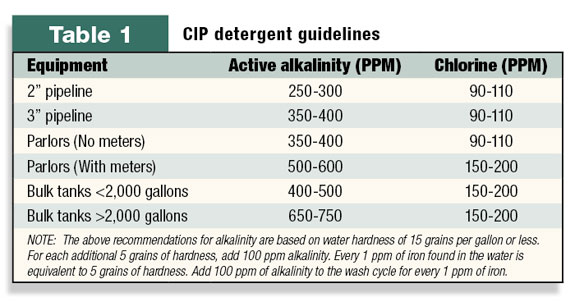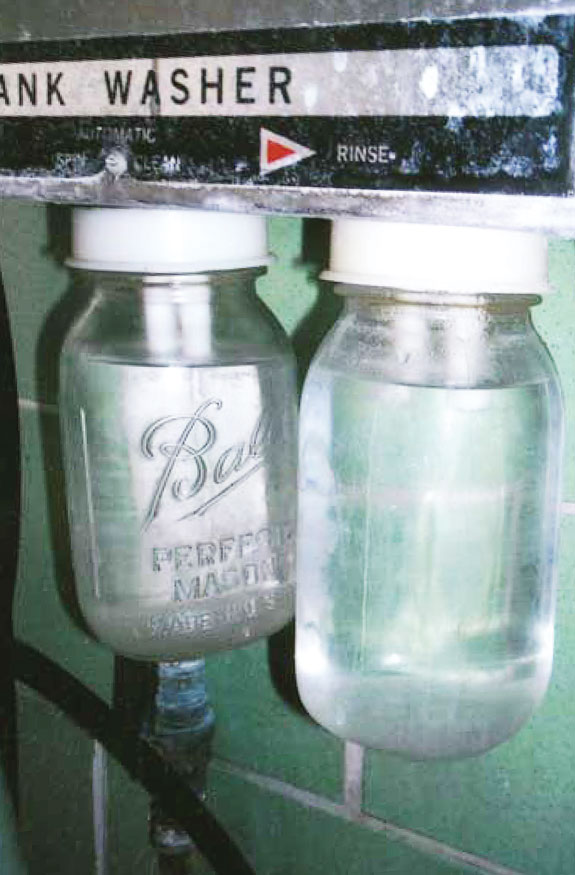Technology. Innovation. Modernization. Change. Are these “scary” words for you? As dairy producers, I’m sure you hear and read about all the new and innovative technologies available to you that will help improve profits, safety and time. But how many of these changes will truly generate a return on your investment? As we walk through dairy operations, we help producers determine what they need to do to profitably produce higher quantities of higher-quality milk. Sometimes our recommendation is focused on udder hygiene.
Sometimes we recommend changes in milking procedures. And sometimes we recommend an upgrade in equipment.
Such was the case with a farm we recently visited in Idaho. The glass chemical jars in this washer system ( see photo ) were designed back in the 1960s and ’70s. Back then, these systems mostly were set up to clean pipelines in stanchion barns.
As operations expand and parlors become larger and more prevalent, these washer systems have become antiquated. However, many producers and equipment dealers are still trying to make them work.
The problem is that these old jars often can’t hold the necessary amount of chemicals for proper cleaning and sanitizing. When filled to the top, the jars at this Idaho dairy held a maximum of 250 ppm of alkalinity.
We calculated that the double-10 parlor (which used about 100 gallons of water per “typical” detergent cycle) actually needed almost 600 ppm of alkalinity. The parlor was more than twice the size of what the washer system could properly handle.
I felt bad for the farmer. He recently expanded and relied on his equipment dealer to finalize all the plans. The parlor system was designed to maximize milk production, but not designed to clean. And high bacteria counts followed. An investment in a new modern washer system was definitely warranted on this operation.
Old truck vs. new truck
I equate the glass jar washer system to my old 1962 Chevy truck. At the time it was made, the truck worked just fine and did the job it was expected to do.
However, if you have been in the market for a new truck lately, I’m sure you’re aware of all the new features and technology truck manufacturers offer nowadays. Compared to the trucks they made back in the 1960s, today’s models offer improved safety, better gas mileage and much more comfort.
The same is true of modern-day washer systems. Their features and technology offer improved safety and overall efficiency.
On the Idaho dairy, we recommended an upgrade to an automatic washer system with a peristaltic pump. These innovative pumps are much safer because they automatically inject detergents and acids, while the old system required manual pumping.
Fully automated, the new system also allows you to set each cycle according to your operational needs. For example, the Idaho producer’s old system had a non-adjustable 10-minute wash cycle.
However, there wasn’t enough hot water to cycle for 10 minutes and maintain an end-of-cycle temperature of 120°F. The new washer systems can be controlled down to the second.

What works for you?
There are many variables that factor into how much detergent your system will need, including pipe size and whether or not you have a meter. Table 1 outlines our basic cleaning guidelines.
The recommended levels of alkalinity found in Table 1 are based on measurements of active alkalinity (as sodium hydroxide) from liquid detergents. If powdered detergents are used, the measurements will not be accurate.
In this case, producers should use the detergent’s dilution chart to determine whether the correct amount of detergent has been added. Following these guidelines will result in better, faster and safer cleaning, plus less system damage.
How’s your system performing?
Ask your chemical provider to complete a thorough chemical survey of your CIP system every six months. And remember to include a chemical expert in discussions regarding expansion plans or any equipment upgrades. Including them upfront helps ensure effective CIP performance in the future.
Speaking of upgrades in equipment … the Idaho producer with the antiquated jars took our advice and installed a new washer system with a peristaltic pump. After months of high bacteria counts, he now has SPC counts consistently below 6,000, PI counts below 10,000, LPC counts below 10 and coliform counts below 10. This change definitely was worth the investment. PD

CIP CHALLENGE
The glass chemical jars in this washer system were designed back in the 1960s and ’70s.
Back then, these systems mostly were set up to clean pipelines in stanchion barns.
As operations expand, these old jars often can’t hold the necessary amount of chemicals for proper cleaning and sanitizing. Photo courtesy of Ron Robinson.
Want to know how well your CIP system is doing? Submit a photo of your CIP challenges or a question to Progressive Dairyman . In future issues, A&L Laboratories experts will comment on the photos or questions. Dairy names and locations will not be connected with photos, so your review will be completely anonymous. Send your photos and questions to walt@progressivedairy.com

-
Ron Robinson
- Vice President of Business Development
- A&L Laboratories
- Email Ron Robinson






